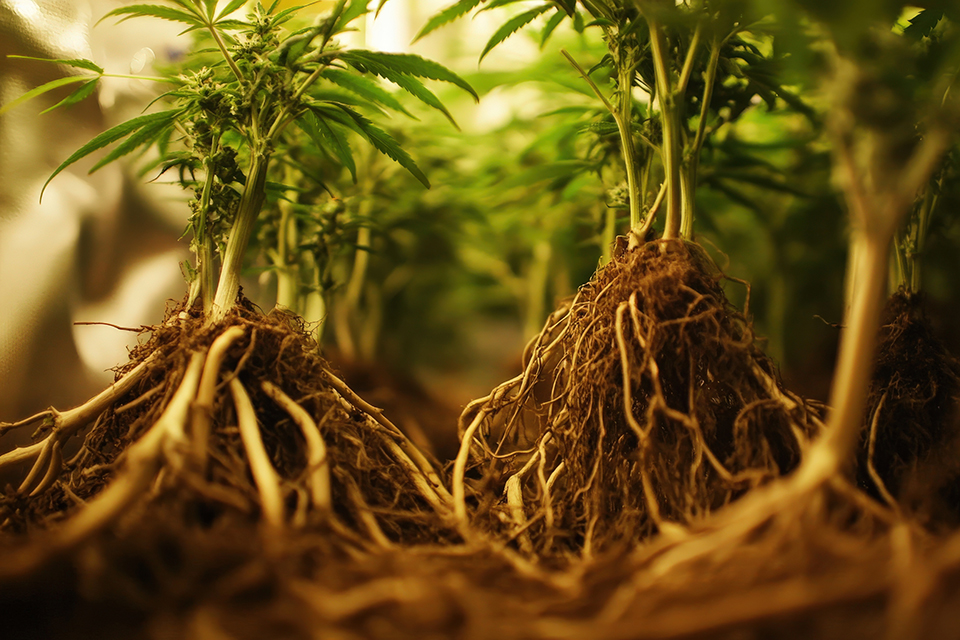
Understanding the cannabis root zone is crucial for healthy and productive plants. At Kind Seed Co, we emphasize the importance of a healthy root zone for achieving superior yields and quality. Whether you’re new to growing or have years of experience, these six tips for learning the cannabis root zone will help you optimize your crop and view Kind Seed Co as a trusted resource for cannabis cultivation advice.
Why the Cannabis Root Zone Is Crucial
The root zone is crucial for the health and productivity of cannabis plants. It anchors the plant, absorbs water and nutrients, and supports essential biological functions. A well-maintained root zone can lead to a more bountiful harvest.
Tip 1: The Root Zone Composition
A thriving cannabis plant starts with a well-balanced root zone, containing soil, water, and air. Soil serves as the main growing medium, providing essential nutrients and moisture. It should be well-draining and rich in nutrients to avoid waterlogging and ensure a steady supply of elements necessary for growth.
Water is key for nutrient absorption and cellular functions. Keeping the root zone at the right moisture level avoids stress. Overwatering can cause root rot, while underwatering may lead to nutrient deficiencies and hinder growth.
Roots need oxygen for respiration. It is essential for energy production and nutrient uptake. Proper aeration prevents anaerobic conditions that can lead to harmful microbial growth and root diseases.
Tip 2: Monitoring Root Zone pH Levels
Keeping an eye on the pH levels is key to ensuring your plants can absorb nutrients effectively. Cannabis prefers a slightly acidic environment, ideally between 6.0 and 7.0 pH for soil. Straying from this range can lead to nutrient lockout, where essential elements like calcium, magnesium, iron, and manganese become inaccessible, causing deficiencies and poor growth.
Use a reliable pH testing kit or a digital meter to monitor pH levels. Regular checks are crucial, especially after adding new nutrients or if you spot signs of nutrient issues, such as yellowing leaves. If you need to adjust the pH up or down, solutions can help bring the soil back to the sweet spot. Adding organic matter like compost can also help stabilize pH levels naturally.
Tip 3: Ensuring Proper Root Zone Aeration
Getting the right amount of air to your cannabis roots contributes to their health. Roots need oxygen to function properly, which helps them absorb nutrients and grow strong. Without enough air, roots can suffocate, leading to weak plants and more disease problems.
Start with a soil mix including perlite or coco coir to boost aeration. These ingredients create air pockets and improve drainage, preventing the soil from becoming too compacted. This setup allows roots to spread out and access the oxygen they need.
Avoid overwatering, as it can drown the roots by saturating the soil with too much water and not enough air. Instead, water deeply but less often, letting the topsoil dry out between waterings. This helps maintain a healthy balance of moisture and air.
Water is key for nutrient absorption and cellular functions. Keeping the root zone at the right moisture level avoids stress. Overwatering can cause root rot, while underwatering may lead to nutrient deficiencies and hinder growth.
Roots need oxygen for respiration. It is essential for energy production and nutrient uptake. Proper aeration prevents anaerobic conditions that can lead to harmful microbial growth and root diseases.
Tip 4: Managing Root Zone Moisture Levels
Keeping the right moisture balance in the root zone is crucial for cannabis plant health. Too much or too little water can lead to problems like root rot or nutrient deficiencies, which can stunt growth and lower yields. Know your plants’ water needs at different stages. Young plants and seedlings need more frequent watering but do not overdo it. Aim for soil that’s moist but not soggy.
Consider adding mulch or cover crops to help retain moisture and reduce evaporation. These methods create a stable environment for roots and minimize stress from moisture fluctuations. Mastering moisture management can help your cannabis plants thrive, leading to healthier growth and better yields.
Tip 5: Nutrient Management in the Root Zone
Cannabis plants need a balanced diet of macronutrients (nitrogen, phosphorus, and potassium) and micronutrients (calcium, magnesium, and iron). Nitrogen fuels leaf growth, while phosphorus is key for roots and flowers.
Choose the right fertilizer. During the vegetative phase, opt for a nitrogen-rich formula. As plants transition to flowering, switch to fertilizers higher in phosphorus and potassium. Regular soil testing is a smart practice to ensure nutrient levels are optimal. These tests can reveal deficiencies and guide necessary adjustments.
Tip 6: Identifying and Addressing Root Zone Problems
Root rot often results from overwatering and poor drainage, which deprives roots of oxygen. Look for signs like yellowing leaves, wilting, and a bad smell from the roots. To prevent this, ensure your growing medium drains well and avoid waterlogging. Using beneficial microbes or hydrogen peroxide if root rot is present can help clean and improve the root environment.
Nutrient lockout happens when pH levels are off, blocking nutrient absorption. This can cause leaves to turn yellow or brown and stunt growth. Regular pH checks and adjustments are key to avoiding this. Flushing the root zone with pH-balanced water can reset nutrient uptake if a lockout occurs.
Successful Root Zones for Successful Cannabis Cultivation
Mastering the cannabis root zone is key to successful cultivation. Home growers can boost plant resilience, growth, and yield by honing in on the root zone’s health and composition. Kind Seed Co supports your journey with expert advice and quality resources. Prioritizing the root zone can cultivate a thriving cannabis crop and showcase effective growing techniques.



